Outcome Expectations and Physical Activity
| SHARE: | |||||
Original Article
Outcome Expectations and Physical Activity in Persons With Longstanding Multiple Sclerosis
Journal of Neuroscience Nursing
Janet D. Morrison, Alexa K. Stuifbergen
ABSTRACT
Research suggests that persons with multiple sclerosis (MS) are much less physically active than the general population and that increased physical activity in persons with MS is associated with numerous benefits such as improvements in fatigue, mobility, and quality of life (Motl & Pilutti, 2012). Potentially modifiable theory-based determinants of physical activity behavior need to be identified so that researchers may study their effectiveness in randomized clinical trials and clinicians may integrate them into practice to promote physical activity in this population. The purpose of this study was to explore the multidimensional (physical, social, and self-evaluative) outcome expectations for physical activity among persons with longstanding MS. A sample of 369 participants diagnosed with MS for more than 15 years completed surveys to measure multidimensional outcome expectations for exercise, MS functional limitations, and physical activity using two different instruments: one measuring physical activity engagement and the other measuring physical activity capability. Results indicated that MS functional limitation was the strongest predictor of both physical activity engagement and physical activity capability. Physical and social outcome expectations contributed to the model explaining 12% of the variation in physical activity engagement, whereas none of the outcome expectancy dimensions (physical, social, or self-evaluative) contributed to the model explaining variation in physical activity capability. Although analyses of cross-sectional data do not infer causation, these findings suggest that positive physical and social outcome expectations for physical activity are associated with engagement in physical activity as well as being potential sources of motivation for increasing physical activity behavior in individuals living with longstanding MS.
A growing body of scientific research suggests that regular physical activity may have beneficial influences on physiological and psychosocial sequelae of living with multiple sclerosis (MS), yet challenging personal, social, and environmental barriers to physical activity exist (Hebert, Corboy, Manago, & Schenkman, 2011; Motl & Gosney, 2008; Rietberg, Brooks, Uitdehaag, Kwakkel, 2004; Vollmer et al., 2012). Physical inactivity contributes to a progressively sedentary lifestyle and intensifies physical deconditioning and functional impairment as well as the likelihood of developing secondary chronic conditions (e.g., cardiovascular disease, osteoporosis, depression, type 2 diabetes) as this population ages (Dalgas, Stenager, & Ingemann-Hansen, 2008). Effective, theory-based interventions are needed, which promote the initiation and maintenance of physical activity behaviors among persons aging with MS (Nelson et al., 2007). Constructs derived from Bandura’s (1986) social cognitive theory offer meaningful foci for interventions designed to foster physical activity behaviors in persons with MS (Suh, Weikert, Dlugonski, Sandroff, & Motl, 2011). Although much has been reported on relationships among self-efficacy, goal setting, social support, and physical activity behavior in this population, little is known of the relationship between outcome expectations (a key construct of social cognitive theory) and physical activity. A better understanding of outcome expectations for physical activity among persons with longstanding MS will inform theory-driven intervention studies designed to promote these behaviors.
Background
MS, which affects over 400,000 persons in the United States, is characterized by areas of demyelination and axonal loss throughout the central nervous system and leads to a wide array of sensory, motor, and cognitive impairments (National Multiple Sclerosis Society, 2012). The disease commonly strikes young adults in their most active and productive years and is associated with significantly lower levels of physical activity throughout the course of this lifelong chronic disabling disease (Stuifbergen, Blozis, Harrison, & Becker, 2006; Stuifbergen & Roberts, 1997). Increasing and maintaining physical activity behavior in persons with MS is a recurrent theme in studies investigating health promotion and wellness because of its potential to enhance well-being and quality of life (Snook & Motl, 2009; Vollmer et al., 2012). In addition, given evidence from the realm of geriatric research, physical activity may offer a much-needed therapeutic option for improving cognitive function for persons with MS (Motl, Sandroff, & Benedict, 2011).
For the purposes of this study, physical activity is defined as ‘‘any bodily movement produced by skeletal muscles that results in energy expenditure’’ (Caspersen, Powell, & Christenson, 1985). Accurate measurement of physical activity is challenging, especially in persons with MS who commonly experience balance and mobility impairments (Gosney, Scott, Snook, & Motl, 2007). Numerous measures of physical activity exist, and each uniquely conceptualizes and operationalizes physical activity. The two self-report measures used in this study reflect such differences: the Human Activity Profile (HAP; Daughton, Fix, Kass, Bell, & Patil, 1982) that measures respondents’ perceived ability to still do specific activities irrespective of actual frequency (e.g., daily, monthly) and the Health Promoting Lifestyle Profile (HPLP; Walker, Sechrist, & Pender, 1995) that more broadly reflects physical activity behavior by including frequency, duration, and intensity parameters.
Physical activity is a complex behavior influenced by multiple factors. Demographic characteristics (e.g., age, gender, marital status, disease duration, and education) are known to affect health-promoting behaviors such as physical activity (Pender, 1996). Patterns of physical activity in the general population vary with personal factors: men tend to be more active than women, people become more sedentary as they age, and more education is associated with higher levels of leisure time physical activity (Pate et al., 1995). Consideration of these personal factors is a critical first step when exploring relationships between concepts theorized to influence physical activity behavior in persons with MS (Becker, Stuifbergen, Ingalsbe, & Sands, 1989).
Because increasing physical activity and maintenance has the potential to enhance overall well-being and quality of life in the general population, the seeming dearth of research focused on this aspect of the lives of individuals with MS is significant. This study examines possible relationships among multidimensional outcome expectations, personal characteristics, and disease-related factors and physical activity in MS.
Prior reviews have shown that social cognitive constructs, particularly self-efficacy, are powerful predictors of health behavior change in persons including those with MS (Dlugonski, Wo´jcicki, McAuley, & Motl, 2011; Motl, Snook, McAuley, Scott, & Douglass, 2006; Stuifbergen, Becker, Blozis, Timmerman, & Kullberg, 2003). Outcome expectation, an important construct of both Bandura’s social cognitive theory and Pender’s health promotion model, reflects both positive and negative consequences an individual believes may occur by performing a specific behavior and may predict health behavior as well (Bandura, 1986; Pender, 1996). Outcome expectation is a multidimensional construct that includes physical (e.g., body structures and functions), social (e.g., intrapersonal relationships), and self-evaluative (e.g., emotional/ affective reflections) components. Although little research has been conducted on the significance of outcome expectations on physical activity in persons with MS, two recent cross-sectional studies used the Multidimensional Outcome Expectations for Exercise Scale to explore social cognitive correlates of physical activity among inactive individuals with relapsing-remitting MS (Dlugonski et al., 2011; Suh et al., 2011). Findings suggest that self-efficacy is indirectly related to physical activity via self-evaluative outcome expectation, social outcome expectation and physical activity are significantly and moderately related, and those who reported being more physically active were found to have higher social and overall outcome expectation scores (Dlugonski et al., 2011; Suh et al., 2011). Thus, the physical, social, and self-evaluative dimensions of outcome expectations for physical activity may be important mediators of behavior change in persons with MS warranting inclusion in behavioral interventions designed to promote physical activity in persons with MS.
Purpose
This article seeks to explore the physical, social, and self-evaluative dimensions of outcome expectations for physical activity among persons with longstanding MS (defined here as having been diagnosed with MS for more than 15 years), a sample more likely to be sedentary and in greater need of physical activity. The purpose of this study was to examine the relationships among physical activity; personal demographic characteristics (i.e., age, duration of MS, gender, marital status, and years of education), functional limitations; and physical, social, and self-evaluative outcome expectations. Pearson’s correlations and hierarchical regression analysis were conducted to answer the following research questions:
- What are the relationships among multidimensional outcome expectations (physical, social, and self-evaluative), personal characteristics (age, gender, education, marital status), and disease-related variables (functional limitations and disease duration) in persons with longstanding MS?
- How much variance in physical activity engagement, operationalized by the HPLP II physical activity (PA) subscale, can be explained by personal characteristics, functional limitations, and outcome expectations in this sample of persons with longstanding MS?
- How much variance in physical activity capability, operationalized by the HAP adjusted activity score, can be explained by personal characteristics, functional limitations, and outcome expectations in this sample of persons with longstanding MS?
Methods
Participants and Procedures
Data analyzed for this study were collected as part of a larger ongoing (15-year) longitudinal descriptive study of persons with MS. The sample was initially recruited through two chapters of the National MS Society in a southwestern state and advertisements in rural newspapers (Stuifbergen & Roberts, 1997). Participants are community-dwelling residents who have completed an annual questionnaire via the mail. The sample was originally recruited to participate in a cross-sectional descriptive study in 1996 and then, after institutional review board approval in 1999, reconsented to participate in the longitudinal study. This study’s sample consists of 369 eligible participants (those still living and potentially able to participate) of the original 621 participants who joined the longitudinal study in 1999. Annual response rates from eligible participants have remained high, over 83%, throughout the length of the study. Participants annually completed a set of self-report instruments that measure health behaviors, attitudes, functional limitations, and quality of life. In 2011, additional measures of outcome expectations and physical activity were included. The current analysis examined responses to selected variables for the 369 individuals responding to the 2011 survey.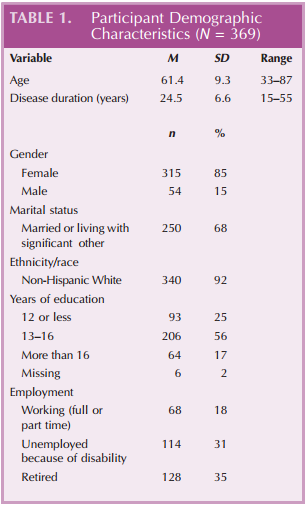
The sample for this study is predominantly women (85%), married (68%), and well educated (73% have more than 12 years of education), findings that are typical among studies of this population. Ages of the participants ranged from 33 to 87 years with an average of 61.4 years (SD = 9.3 years). Average disease duration was 24.5 (SD = 6.6) years. Employment data indicated that 31% were unemployed because of disability and 35% were retired, whereas 18% were employed either full or part-time (see Table 1).
Measures
Demographic Data
Background personal information was collected concerning age, gender, year diagnosed with MS, ethnicity, and education in year 3 of the longitudinal study. Employment and marital status questions are reported from the 2011 survey.
Physical Activity
Two self-report instruments were included to measure physical activity: the HPLP-II PA subscale and the HAP.
HPLP II
The eight-item physical activity subscale, a measure of physical activity engagement, of the HPLP II includes items measuring frequency of physical activity behavior on a 4-point scale: never, sometimes, often, or routinely (Walker et al., 1995). Participant responses broadly reflect the frequency, intensity (vigorous, light-to-moderate, usual daily, and leisure-time activities), and duration of physical activity behaviors. Reliability and validity testing of the HPLP II has been conducted using samples of community-living adults and those with chronic disabling conditions such as MS (Stuifbergen et al., 2003; Walker & Hill-Polrecky, 1996). Significant associations between the physical activity subscale and indices of strength and flexibility have been reported in persons with MS (Stuifbergen, 1995; Stuifbergen et al., 2006). In addition, scores on this subscale were significantly related to performance (r = j.45, p G .01) on a timed 25-foot walk test for a subsample (n = 70) of this group. Internal consistency reliability for this sample was 0.88.
HAP
The HAP measures participants’ perceived ability to perform 94 different physical activities (Daughton et al., 1982). The instrument asks respondents to indicate whether they are still doing, have stopped doing, or never did specific physical activities starting with those requiring low levels of energy expenditure (e.g., getting in and out of a chair or bed) escalating to activities requiring greater levels (e.g., walking, swimming, bicycling) in hierarchical fashion. Designed using a sample of patients with chronic obstructive pulmonary disease in rehabilitation programs, the HAP scale has since been validated among populations with chronic conditions including elderly adults living independently (Fix & Daughton, 1988), older people with polio (Hill & Stinson, 2004), and persons with MS (Packer, Sauriol, & Brouwer, 1994; Stuifbergen, 1997). Two scores are calculated for each participant: the maximum activity score (MAS) interpreted as the highest level of energy expenditure the participant reports being capable of doing and the AAS interpreted as the best estimate of the respondent’s average level of energy expenditure. Extensive construct validity and limited, but consistent, testYretest reliability were reported by Davidson and de Morton (2007) in their systematic review of the HAP.
MS Functional Limitations
The Incapacity Status Scale (Kurtzke, 1981) was used to measure functional limitations because of MS in this study. Developed and validated among persons with MS by the International Federation of Multiple Sclerosis Societies (Wingerchuk, Noseworthy, & Weishenker, 1997) and adapted for use as a self-report survey by Stuifbergen and Roberts (1997), the scale is an inventory of functional limitations for activities of daily living and role performance. A 5-point scale is used to rate 16 domains of personal functioning (e.g., elimination, ambulation, and cognitive performance) with a response of 0 indicating no impairment in activity and 4 reflecting severe or total inability to perform the function. Total scale scores range from 0 to 64. Internal consistency reliability for this measure was 0.86 in this sample.
Outcome Expectations
The Multidimensional Outcome Expectations for Exercise Scale, developed in a sample of middle-aged and older adults by Wo´jcicki, White, and McAuley (2009), is a 19-item scale that measures three conceptually distinct constructs of outcome expectation: physical, social, and self-evaluative. Seven items explore physical dimensions of outcome expectation (e.g., muscle and bone strength, cardiovascular function, ability to perform daily activities), six items explore social dimensions (e.g., acceptance, companionship, social standing), and six items explore self-evaluative dimensions (e.g., personal accomplishment, mental alertness, psychological state). Respondents use a 5-point scale to indicate how strongly they agree or disagree with the 19 statements (1 = strongly disagree,2= disagree, 3 = neutral,4= agree,5= strongly agree). Evidence of validity with objective and self-reported measures of physical activity and good internal consistency reliability among aging adults and persons with MS has been reported in the literature (McAuley, Motl, White, & Wo´jcicki, 2010; Suh et al., 2011; Wo´jcicki et al., 2009). Internal consistency reliability for the total outcome expectation measure as well as the three subscales ranged from 0.81 to 0.89 in this sample.
Data Analysis
Data were analyzed using IBM SPSS version 20.0.0 (IBM Corp., Armonk, NY) after being proofed for accuracy by research staff. Six participants (1.6% of the sample) did not report their number of years of education, and one (0.3% of the sample) did not indicate the year he or she was diagnosed with MS. The participants with missing data were excluded from the correlation and regression analyses. Summary descriptive statistics, including frequencies, means, and standard deviations, were used to assess participant characteristics. Pearson productYmoment correlations were conducted on scores from the HPLP-II PA subscale, HAP AAS, age, disease duration, and the three dimensions of outcome expectation (physical, social, and self-evaluative). Kendall’s tau correlations were computed for the dichotomous variables: gender (female = 0, male = 1) and marital status (not married = 0, married or living with a significant other = 1). Separate hierarchical regression analyses were conducted to predict physical activity as conceptualized and operationalized by the HPLP-II PA subscale (physical activity engagement) and the HAP AAS (physical activity capability). In each case, step 1 included five personal characteristics as predictors (age, disease duration, gender, years of education, and marital status); step 2 included the MS-Incapacity Status Scale, a measure of MS-related functional limitations; and step 3 added the physical, social, and self-evaluative outcome expectation subscales. The rationale for the order of entry was based on Pender’s (1996) health promotion model. The squared correlation coefficient (r 2 ) and change in r 2 (r 2 change) were used to determine the amount of variation explained by the combined predictor variables at each step of the hierarchical model.
Results
Descriptive statistics (means and standard deviations) were computed for this sample of 369 individuals with longstanding MS (see Table 2). Cronbach’s alpha for all summated scales exceeded .80. Mean average item scores were highest for physical outcome expectancy (4.2 T 0.1), followed by self-evaluative outcome expectancy (4.1 T 0.1), then social outcome expectancy (3.2 T 0.3).
The HAP, one of the two measures of physical activity used for this study, provides two scores: the MAS that reflects the highest level of activity the individual reports still being able to engage in and the AAS, a reflection of current activity that adjusts for activities the person has stopped doing. This sample had lower scores than norms reported for healthy adults, older adults, and individuals with chronic pain by Fix and Daughton (1988) but scores similar to a sample of 37 adults with MS reported by Stuifbergen (1997). For this sample, MASs were higher than those with 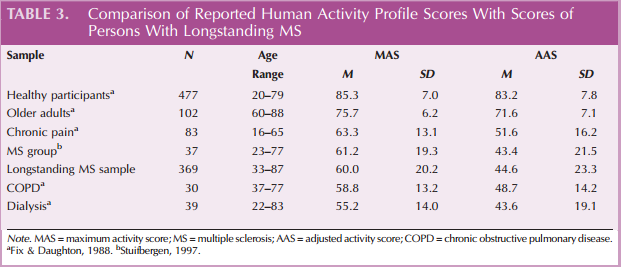 chronic obstructive pulmonary disease, whereas their AASs were lower. Greater variation (SD) was found in maximum and AASs among persons with MS compared with all other groups (see Table 3).
chronic obstructive pulmonary disease, whereas their AASs were lower. Greater variation (SD) was found in maximum and AASs among persons with MS compared with all other groups (see Table 3).
Pearson’s bivariate correlations indicate that a moderate (r = .47, p G .01) positive linear relationship exists between the two measures of physical activity, the HPLP-II PA subscale and HAPAAS (see Table 4). Statistically significant, positive, linear relationships exist between the two physical activity measures and the three outcome expectation measures, yet the strength of the relationships is stronger among HPLP-II PA subscale scores (r = .44, .36, and .41) than among HAP AASs (r = .36, .16, and .28). Moderate-to-strong positive correlations were found among the three outcome expectation subscale scores indicating that physical, social, and self-evaluative outcome expectations may be valuable constructs to include in physical activity promotion interventions.
We performed hierarchical linear regression analyses to predict physical activity twice: first, using the HPLP-II PA subscale (physical activity engagement), and second, using the HAP AAS (physical activity capability). The independent variables were entered in three blocks: (1) personal characteristics (2), functional limitations, and (3) multidimensional outcome expectations. Therefore, it was possible to examine the predictive utility of the multidimensional outcome expectation variables, controlling for the effects of personal characteristics as well as 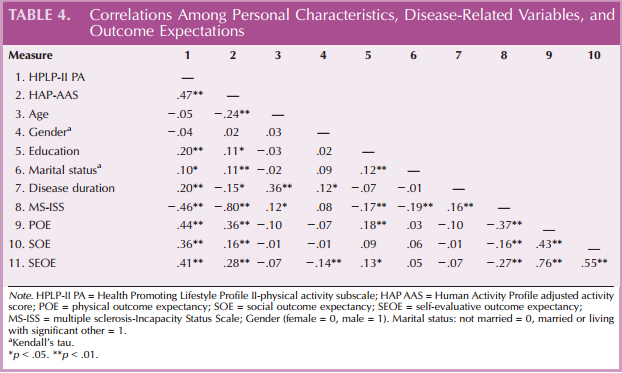 functional limitation because of MS in both analyses. Results showed that all variables in the model, when considered together, contributed toward the 34.6% variance explained in HPLP-II PA subscale scores and 66.1% of the variance explained in HAP AAS scores (see Tables 5 and 6). Personal characteristics explained 5.2% of the variation in the HPLP II ($r 2 = .052, p G .01) and 9.7% in the HAP AAS ($r 2 = .097, p G .01) in step 1 of the model. MS functional limitations (MS-ISS) explained an additional 17.9% of the variation in the HPLP II ($r 2 = .179, p G .01) and 55.8% in the HAP AAS ($r 2 = .558, p G .01) in step 2. Although physical and social outcome expectations added 11.5% to explain variance in the HPLP II ($r 2 = .115, p G .01), none of the three outcome expectations explained significant variation in the HAP AAS ($r 2 = .006, p = .10) in step 3.
functional limitation because of MS in both analyses. Results showed that all variables in the model, when considered together, contributed toward the 34.6% variance explained in HPLP-II PA subscale scores and 66.1% of the variance explained in HAP AAS scores (see Tables 5 and 6). Personal characteristics explained 5.2% of the variation in the HPLP II ($r 2 = .052, p G .01) and 9.7% in the HAP AAS ($r 2 = .097, p G .01) in step 1 of the model. MS functional limitations (MS-ISS) explained an additional 17.9% of the variation in the HPLP II ($r 2 = .179, p G .01) and 55.8% in the HAP AAS ($r 2 = .558, p G .01) in step 2. Although physical and social outcome expectations added 11.5% to explain variance in the HPLP II ($r 2 = .115, p G .01), none of the three outcome expectations explained significant variation in the HAP AAS ($r 2 = .006, p = .10) in step 3.
Discussion
This study was designed to explore multidimensional outcome expectations for physical activity in persons with longstanding MS using two different self-report measures of physical activity. The HPLP II broadly measures physical activity engagement by including intensity, duration, and frequency of both planned and lifestyle physical activity, whereas the HAP is more narrowly focused on participant’s perceived capability to engage in an activity regardless of frequency or duration. Although a strong association between the measures is expected, considerable variance is left unexplained reflecting the differences in the two measure’s conceptualization and operationalization of physical activity.
MS functional limitation was found to be the strongest predictor of physical activity in this sample of persons with 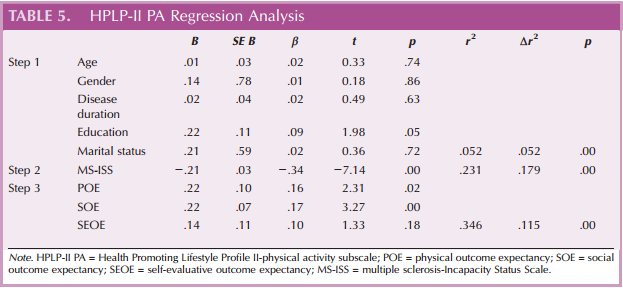 longstanding MS using either measure of physical activity, and multidimensional outcome expectations more strongly correlated with the HPLP II than with the HAP. This variation in the relationship between predictors and physical activity outcomes was consistent with the differences in the conceptualization and operationalization of physical activity in the two physical activity measures. The disablement process (Verbrugge & Jette, 1994, p. 4) conceptualizes disability arising from ‘‘difficulty doing an activity in any domain of life and functional limitations as restrictions in basic physical and mental actions.’’ The HPLP II is more congruent with physical activity conceptualized as disability, what the person with MS does do; whereas the HAP conceptualizes physical activity as a functional limitation, what the person with MS can do. Conceptually, it makes sense that the positive and negative outcomes the individual anticipates to occur from physical activity may explain variation in behavior the individual actually does do, although these same outcome expectations do not explain variation in what the person is physically capable of doing.
longstanding MS using either measure of physical activity, and multidimensional outcome expectations more strongly correlated with the HPLP II than with the HAP. This variation in the relationship between predictors and physical activity outcomes was consistent with the differences in the conceptualization and operationalization of physical activity in the two physical activity measures. The disablement process (Verbrugge & Jette, 1994, p. 4) conceptualizes disability arising from ‘‘difficulty doing an activity in any domain of life and functional limitations as restrictions in basic physical and mental actions.’’ The HPLP II is more congruent with physical activity conceptualized as disability, what the person with MS does do; whereas the HAP conceptualizes physical activity as a functional limitation, what the person with MS can do. Conceptually, it makes sense that the positive and negative outcomes the individual anticipates to occur from physical activity may explain variation in behavior the individual actually does do, although these same outcome expectations do not explain variation in what the person is physically capable of doing.
These findings suggest that positive physical and social outcomes attributable to physical activity participation are associated with physical activity behavior in individuals with longstanding MS. Our results complement those found in the study by Ferrier, Dunlop, and Blanchard (2010), who used a single-dimension measure of outcome 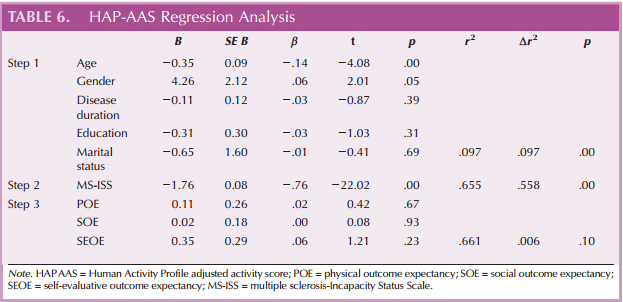 expectation among persons with MS suggesting that outcome expectancy was associated with increased physical activity levels and may be a potential source of motivation for increasing physical activity in this population. The documented benefits of physical activity among persons with MS include improved fatigue and reduced anxiety (self-evaluative outcomes), improved walking speed and muscle tone (physical outcomes), and companionship (social outcomes), which may be potent physical activity motivators for this population and warrants further investigation (Hebert et al., 2011; Oken et al., 2004; Rietberg et al., 2004). Future physical activity promotion intervention studies should include content related to the physical and social benefits of physical activity in addition to other social cognitive determinants (e.g., self-efficacy and goal setting).
expectation among persons with MS suggesting that outcome expectancy was associated with increased physical activity levels and may be a potential source of motivation for increasing physical activity in this population. The documented benefits of physical activity among persons with MS include improved fatigue and reduced anxiety (self-evaluative outcomes), improved walking speed and muscle tone (physical outcomes), and companionship (social outcomes), which may be potent physical activity motivators for this population and warrants further investigation (Hebert et al., 2011; Oken et al., 2004; Rietberg et al., 2004). Future physical activity promotion intervention studies should include content related to the physical and social benefits of physical activity in addition to other social cognitive determinants (e.g., self-efficacy and goal setting).
Nurses are in a unique position to promote physical activity among their patients with chronic disabling conditions such as MS. Interactions (e.g., clinic visits, inpatient stays, telephone calls) with patients offer prime opportunities to explore physical activity behaviors and beliefs with individuals when they are receptive to communication with healthcare providers. Nurses can begin by exploring what physical activity outcome expectations (beliefs) the individual holds. Findings from this study indicate that positive physical and social outcomes are associated with increased physical activity behavior. Nurses can validate and encourage positive physical outcome beliefs (improvements in body functioning and better ability to perform activities, stronger muscles and bone) and social outcome beliefs (positive contact with friends, meeting new people, companionship) as strategies to promote physical activity. Exploring negative outcome expectations (e.g., pain, fatigue) may provide an opportunity to devise compensatory strategies such as planning physical activities for the morning when well rested and breaking activities into short 10-minute sessions a couple times a day. Barriers to physical activity are another important topic to explore with patients, as transportation and accessibility issues are common barriers to participation in physical activity for this population (Becker & Stuifbergen, 2004). Discussions with the patient should also include setting realistic goals based on the patient’s current level of physical activity and functional limitations. Federal physical activity guidelines for adults with disabilities recommend at least 150 minutes per week of moderate-intensity physical activity to promote health (U.S. Department of Health and Human Services, 2008). This guideline may be daunting so individuals should be counseled to start slowly by adding a few minutes each week to their current level of physical activity and to divide episodes of physical activity into short 10-minute segments distributed evenly over the week to minimize fatigue. Patients may need guidance in adapting activities to their personal needs or finding accessible facilities. Nurses can assist patients by sharing community resources (transportation services, adaptive fitness programs) and making referrals (National MS Society, Can Do MS) to address their needs.
Limitations of this study include a lack of demographic diversity in this predominantly well-educated, White, married, female sample with longstanding MS. The cross-sectional design and correlational analyses prohibit attributing causal means to the findings. In addition, participants are ‘‘survivors’’ in a 15-year longitudinal study and may differ in unknown ways from other groups of persons with longstanding MS. To our knowledge, this is the first study published on physical activity where the entire sample is known to have longstanding MS (MS diagnosis for more than 15 years).
Physical and social outcome expectations may be valid sources of motivation for increasing physical activity among persons with longstanding MS. Multidimensional outcome expectations correlated higher with physical activity defined broadly to include daily and leisure-time activities (HPLP II) than defined narrowly as physical capability (HAP), which is chiefly influenced by disease progression and functional capability. Findings support the expected theoretical relationships between outcome expectations and selfreported physical activity behavior. Additional research is needed to explore if interventions to enhance multidimensional outcome expectation for physical activity would result in increases in physical activity participation in persons with longstanding MS.
Acknowledgments
This project was supported by Grant R01NR003195, NINR, NIH.
References
Bandura, A. (1986). Social foundations of thought and action: A social cognitive theory. Englewood Cliffs, NJ: Prentice-Hall.
Becker, H., & Stuifbergen, A. (2004). What makes it so hard? Barriers to health promotion experienced by people with multiple sclerosis and polio. Family and Community Health, 27, 75Y85.
Becker, H. A., Stuifbergen, A. K., Ingalsbe, K., & Sands, D. (1989). Health promoting attitudes and behaviors among persons with disabilities. International Journal of Rehabilitation Research, 12, 235Y250.
Caspersen, C. J., Powell, K. E., & Christenson, G. M. (1985). Physical activity, exercise, and physical fitness: Definitions and distinctions for health-related research. Public Health Reports, 100, 126Y131.
Dalgas, U., Stenager, E., & Ingemann-Hansen, T. (2008). Multiple sclerosis and physical exercise: Recommendations for the application of resistance-, endurance- and combined training. Multiple Sclerosis, 14, 35Y53. doi:10.1177/1352458507079445
Daughton, D. M., Fix, A. J., Kass, I., Bell, C. W., & Patil, K. D. (1982). Maximum oxygen consumption and the ADAPT quality-of-life scale. Archives of Physical Medicine and Rehabilitation, 63, 620Y622. Davidson, M., & de Morton, N. (2007). A systematic review of the Human Activity Profile. Clinical Rehabilitation, 21, 151Y162. doi:10.1177/0269215506069475
Dlugonski, D., Wo´jcicki, T. R., McAuley, E., & Motl, R. W. (2011). Social cognitive correlates of physical activity in inactive adults with multiple sclerosis. International Journal of Rehabilitation Research, 34, 115Y120. doi:10.1097/MRR .0b013e328342ddc0
Ferrier, S., Dunlop, N., & Blanchard, C. (2010). The role of outcome expectations and self-efficacy in explaining physical activity behaviors of individuals with multiple sclerosis. Behavioral Medicine, 36, 7Y11. doi:10.1080/08964280903521354
Fix A., & Daughton D. (1988). Human activity profile: Professional manual. Odessa, FL: Psychological Assessment Resources.
Gosney, J. L., Scott, J. A., Snook, E. M., & Motl, R. W. (2007). Physical activity and multiple sclerosis: Validity of self-report and objective measures. Family and Community Health, 30, 144Y150.
Hebert, J. R., Corboy, J. R., Manago, M. M., & Schenkman, M. (2011). Effects of vestibular rehabilitation on multiple sclerosis related fatigue and upright postural control: A randomized controlled trial. Physical Therapy, 91, 1166Y1183. doi:10.2522/ptj .20100399
Hill, K. D., & Stinson, A. T. (2004). A pilot study of falls, fear of falling, activity levels and fall prevention actions in older people with polio. Aging Clinical and Experimental Research, 16, 126Y131.
Kurtzke, J. F. (1981). A proposal for a uniform minimal record of disability in multiple sclerosis. Acta Neurologica Scandinavica, 64(s87), 110Y129.
McAuley, E., Motl, R. W., White, S. M., & Wo´jcicki, T. R. (2010). Validation of the multidimensional outcome expectations for exercise scale in ambulatory, symptom-free persons with multiple sclerosis. Archives of Physical Medicine and Rehabilitation, 91, 100Y105. doi:10.1016/j.apmr.2009.09.011
Motl, R. W., & Gosney, J. L. (2008). Effect of exercise training on quality of life in multiple sclerosis: A meta-analysis. Multiple Sclerosis, 14, 129Y135. doi:10.1177/1352458507080464
Motl, R. W., & Pilutti, L. A. (2012). The benefits of exercise training in multiple sclerosis. Nature Reviews: Neurology, 8, 487Y497. doi:10.1038/nrneurol.2012.136
Motl, R. W., Sandroff, B. M., & Benedict, R. H. (2011). Cognitive dysfunction and multiple sclerosis: Developing a rationale for considering the efficacy of exercise training. Multiple Sclerosis, 17, 1034Y1040. doi:10.1177/1352458511409612
Motl, R. W., Snook, E. M., McAuley, E., Scott, J. A., & Douglass, M. L. (2006). Correlates of physical activity among individuals with multiple sclerosis. Annals of Behavioral Medicine, 32, 154Y161. doi:10.1207/s15324796abm3202_13
National Multiple Sclerosis Society. (2012). Who gets MS? Retrieved from http://www.nationalmssociety.org/about-multiplesclerosis/what-we-know-about-ms/who-gets-ms/index.aspx
Nelson, M. E., Rejeski, W. J., Blair, S. N., Duncan, P. W., Judge, J. O., King, A. C., I Castaneda-Sceppa, C. (2007). Physical activity and public health in older adults: Recommendation from the American College of Sports Medicine and the American Heart Association. Circulation, 116, 1094Y1105. doi:10.1161/ CIRCULATIONAHA.107.185650
Oken, B. S., Kishiyama, S., Zajdel, D., Bourdette, D., Carlsen, J., Haas, M., I Mass, M. (2004). Randomized controlled trial of yoga and exercise in multiple sclerosis.Neurology, 62, 2058Y2064.
Packer, T. L., Sauriol, A., & Brouwer, B. (1994). Fatigue secondary to chronic illness: Postpolio syndrome, chronic fatigue syndrome and multiple sclerosis. Archives of Physical Medicine and Rehabilitation, 75, 1122Y1126. doi:10.1016/ 0003-9993(94)90088-4
Pate, R. R., Pratt, M., Blair, S. N., Haskell, W. L., Macera, C. A., Bouchard, C., I King, A. C. (1995). Physical activity and public health. A recommendation from the Centers for Disease Control and Prevention and the American College of Sports Medicine. Journal of the American Medical Association, 273, 402Y407.
Pender, N. J. (1996). Health promotion in nursing practice. Stamford, CT: Appleton-Lange.
Rietberg, M. B., Brooks, D., Uitdehaag, B. M. J., & Kwakkel, G. (2004). Exercise therapy for multiple sclerosis. Cochrane Database of Systematic Reviews, 3, CD003980. doi:10.1002/ 14651858.CD003980.pub2
Snook, E. M., & Motl, R. W. (2009). Effect of exercise training on walking mobility in multiple sclerosis: A meta-analysis. Neurorehabilitation and Neural Repair, 23, 108Y116. doi:10 .1177/1545968308320641
Stuifbergen, A. K. (1995). Health-promoting behaviors and quality of life among individuals with multiple sclerosis. Scholarly Inquiry for Nursing Practice, 9, 31Y50.
Stuifbergen, A. K. (1997). Physical activity and perceived health status in persons with multiple sclerosis. Journal of Neuroscience Nursing, 29, 238Y243.
Stuifbergen, A. K., Becker, H., Blozis, S., Timmerman, G., & Kullberg, V. (2003). A randomized clinical trial of a wellness intervention for women with multiple sclerosis. Archives of Physical Medicine and Rehabilitation, 84, 467Y476. doi:10 .1053/apmr.2003.50028
Stuifbergen, A. K., Blozis, S. A., Harrison, T. C., & Becker, H. A. (2006). Exercise, functional limitations, and quality of life: A longitudinal study of persons with multiple sclerosis. Archives of Physical Medicine and Rehabilitation, 87, 935Y943. doi:10 .1016/j.apmr.2006.04.003
Stuifbergen, A. K., & Roberts, G. J. (1997). Health promotion practices of women with multiple sclerosis. Archives of Physical Medicine and Rehabilitation, 78, S3YS9.
Suh, Y., Weikert, M., Dlugonski, D., Sandroff, B., & Motl, R. W. (2011). Social cognitive correlates of physical activity: Findings from a cross-sectional study of adults with relapsing remitting multiple sclerosis. Journal of Physical Activity and Health, 8, 626Y635.
U.S. Department of Health and Human Services. (2008). 2008 Physical activity guidelines for Americans. Retrieved from http://www.health.gov/paguidelines/pdf/paguide.pdf
Walker, S. N., & Hill-Polrecky, D. (1996). Psychometric evaluation of the Health-Promoting Lifestyle Profile II. In: Proceedings of the 1996 Scientific Session of The American Nurses Association’s Council of Nurse Researchers, Washington, DC.
Walker, S. N., Sechrist, K. R., & Pender, N. J. (1995). The HealthPromoting Lifestyle Profile II. Omaha, NE: Author.
Wingerchuk, D. M., Noseworthy, J. H., & Weinshenker, B. G. (1997). Clinical outcome measures and rating scales in multiple sclerosis trials. Mayo Clinic Proceedings, 72, 1070Y1079. doi:10.1016/S0025-6196(11)63550-7
Wo´jcicki, T. R., White, S. M., & McAuley, E. (2009). Assessing outcome expectations in older adults: The multidimensional outcome expectations for exercise scale. The Journal of Gerontology, Series B, Psychological Sciences and Social Sciences, 64, 33Y40. doi:10.1093/geronb/gbn032
Verbrugge, L. M., & Jette, A. M. (1994). The disablement process. Social Science and Medicine, 38, 1Y14.
Vollmer, T. L., Benedict, R., Bennett, S., Motl, R., White, A., Bombardier, C. H., & Hebert, J. R. (2012). Exercise as prescriptive therapy in multiple sclerosis: A consensus conference white paper. International Journal of MS Care, 14(Suppl 3), 2Y14.
